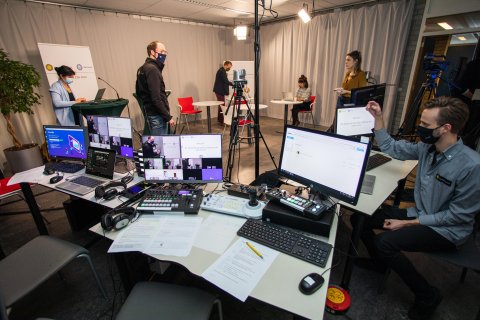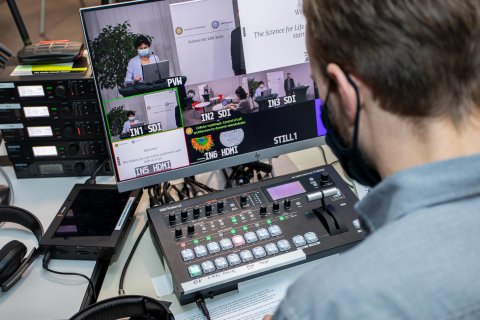The academic conference in 2020: only the backstage area remains
Taking part in international conferences is an important part of conducting science. Due to the corona pandemic in 2020, online conferences were experimented with on a large scale. Which of these lessons can we take into 2021?

It’s a grey Monday in Utrecht Science Park, in a backroom on Bolognalaan, where the first speakers for one of these conferences are trickling in. Like many other conferences, this year’s Science for Life conference is taking place digitally for the first time. What originally started as an emergency corona measure turned into a mass experiment for the scientific conference of the future. With new knowledge and experience in its pocket, Utrecht University is taking stock of what this could mean for future conferences.
Less flying in science
Jeroen Bugter, a researcher in molecular biology at UMC Utrecht, shares his experience on what it’s like to be a presenter on this day. “As a third-year PhD student, I hoped to attend my first major international conference this year. After all, it is in this context that you can build a valuable network. That has proven much more difficult now, as it is much easier to have a quick chat while queuing for a coffee. At the same time, international conferences involve a lot of travel. We could do with less of that”. In 2019, 15 percent of Utrecht University’s CO2 emissions came from air travel. De Jonge Akademie has been calling for less flying in science, and the Executive Board of Utrecht University has been encouraging the use of trains and digital resources over flights since 2019.
In room 1.074, on Bolognalaan, the full might of these digital resources is made visible. A year ago, this was just a classroom with a simple projector. Now it is a professional recording studio equipped with various cameras and monitors. Erik van Zwol, coordinator of science communication at the Life Sciences faculty, takes us through how everything was arranged. “We made a whole choreography”, he said. The conference which – only a year ago - brought hundreds of people together in the Jaarbeurs to mingle, is now a backstage affair. As he shoves a box of biscuits out of the camera’s sight, Erik goes on, “each speaker has to come in to take their place behind the microphone, and then move on to the nearest table when done to avoid having people walk past each other”.

Room for hybrid forms
People like Erik have been gaining a lot of practical experience this year. “It is now important to ensure that the lessons learned are shared”, says Martine van Willenswaard of the Facility Service Centre. Together with colleagues, she launched the ‘Online conferences’ toolkit (currently only available in Dutch). This toolkit was made from the knowledge and experience gathered from university colleagues over the past months. It is intended to become a living document, which will evolve over time. “One thing is certain: we are not done learning about this field”.
It is now important to ensure that the lessons learned are shared.
Martine thinks that hybrid conferences – conferences that simultaneously take place online and in person – will likely be the future. Jeroen Bugter also foresees a hybrid conference future. This format makes it easier to only attend specific parts of a conference, without jeopardising the potential for something which we have no substitute for: networking. As Martine concludes, “we will continue to experiment with hybrid conferences for a while, so we will be regularly expanding this toolkit”.

Back to the Science for Life conference, there is only one hour to go until kick-off. Sitting in a corner behind his laptop, Erik reports on discussions in the forum. Some are surprised to hear that the breakout session is full. 'How can an online session be full,?' they ask. As the first keynote speaker arrives, greetings feel rather awkward, given the mouth masks and the lack of handshakes. The keynote speaker unzips her large yellow backpack, places her laptop on the speakers’ table, and drops her backpack next to it. Erik giggles and reacts: “I would put your bag at the exit of the room if I were you. It’s a strange sight when you walk out of the room with your backpack on just after a presentation".

Despite the fact that vaccinations against corona have already started in many places around the world, it is likely that this pandemic will leave a permanent mark on the academic conference landscape. It seems that online conferences are here to stay. Luckily, thanks to the new toolkit and the university’s investments, they will continue to improve.
At Bolognalaan, the keynote speaker is ready to begin. “It may not feel like it, but you have a full house. Three hundred people are watching your first session”, Erik tells her. Only the people who are part of the conference programme can stay, so we leave the room. The rest follow the conference through their laptop screens in the corridor. Erik's colleague Corné Pieterse opens the conference and sneaks out of the room with his jacket, bag and laptop in hand. He quietly closes the door behind him. The conference has started.
Green stories
The series 'green stories' aims to give a view into the work by some of the researchers, students and employees that, in various ways, commit themselves to driving sustainable change; in the world and at Utrecht University. #groenverhaal
Would you like to know what else is going on at the UU with regards to sustainability? Take a look at the Sustainability monitor.

